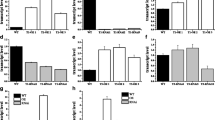Abstract
We have isolated a 1104 bp tobacco cDNA clone (H1c12) which includes an 846 bp open reading frame. This encodes a polypeptide of 282 amino acid residues and represents the largest plant H1 histone identified so far. The structure of the deduced protein shows the classical tripartite organization of the H1-type linker histones. The expression of the tobacco H1 histone gene(s) corresponding to the H1c12 cDNA clone was examined during different developmental stages. We found that, at the level of steadystate mRNA, expression of gene(s) encoding this H1 histone was rapidly induced in germinating seeds. The H1 gene was expressed in all tissues examined. However, its expression was higher in tissues known to contain meristematic cells. Furthermore, in the leaves of mature plants accumulation of the H1 mRNA exhibits a very characteristic oscillation. This latter finding indicates that, at least in fully developed plants, the expression of this type of H1 histone gene(s) is modulated by a diurnal cycle.
Similar content being viewed by others
References
Brandt WF, Holt C: Variants of wheat histone H1 with N- and C-terminal extensions. FEBS Lett 194: 282–286 (1986).
Bresnick EH, Bustin M, Marsaud V, Richard-Foy H, Hager GL: The transcriptionally-active MMTV promoter is depleted of histone H1. Nucl Acids Res 20: 273–278 (1992).
Chaboute ME, Chaubet N, Gigot C, Philipps G: Histones and histone genes in higher plants: structure and genomic organisation. Biochimie 75: 523–531 (1993).
Cole RD: A minireview of microheterogeneity in H1 histone and its possible significance. Anal Biochem 136: 24–30 (1984).
Gantt JS, Key JL: Molecular cloning of a pea H1 histone cDNA. Eur J Biochem 166: 119–125 (1987).
Gantt JS, Lenvik TR: Arabidopsis thaliana H1 histones. Analysis of two members of a small gene family. Eur J Biochem 202: 1029–1039 (1991).
Gigot C: Histone genes in higher plants. In: Kahl G (ed) Architecture of Eukaryotic Genes, pp. 1367–1373. VCH Verlagsgesellschaft, Weinheim, Germany (1988).
Grunstein M: Histone function in transcription. Annu Rev Cell Biol 6: 643–678 (1990).
Hill SC, Rimmer MJ, Green NB, Finch JT, Thomas JO: Histone-DNA interactions and their modulation by phosphorylation of-Ser-Pro-X-Lys/Arg-motifs. EMBO J 10: 1939–1948 (1991).
Jost JP, Hosteenge J: The repressor MDPB-2 is a member of the histone H1 family that binds preferentially in vitro and in vivo to methylated nonspecific DNA sequences. Proc Natl Acad Sci USA 89: 9499–9503 (1992).
Katagiri F, Lam E, Chua N-H: Two tobacco DNA-binding proteins with homology to the nuclear fractor CREB. Nature 340: 727–730 (1989).
Laybourn JP, Kadonaga TJ: Role of nucleosomal cores and histone H1 in regulation of transcription by RNA polymerase II. Science 254: 238–245 (1991).
Lindauer A, Muller K, Schmitt R: Two histone H1-coding genes of the green alga Volvox carteri with features immediate between plant and animal genes. Gene 129: 59–68 (1993).
Minami M, Huh GH, Yang P, Iwabuchi M: Coordinate gene expression of five subclass histones and the putative transcription factors, HBP-1a and HBP-1b, of histone genes in wheat. Plant Mol Biol 23: 429–434 (1993).
Nagy F, Kay SA, Chua N-H: The analysis of gene expression in transgenic plants. In: Gelvin SB, Schilperoort RA (eds) Plant Gene Research Manual, pp. 1–29. Kluwer Academic Publishers, Dordrecht (1987).
Nagy F, Kay SA, Chua N-H: A circadian clock regulates transcription of the wheat Cab-1 gene. Gene Devel 2: 376–382 (1988).
Piechulla B: ‘Circadian clock’ directs the expression of plant genes. Plant Mol Biol 22: 533–542 (1993).
Osley M: The regulation of histone synthesis in the cell cycle. Annu Rev Biochem 60: 827–861 (1991).
Razafimahatratra P, Chaubet N, Philipps G, Gigot C: Nucleotide sequence and expression of a maize H1 histone cDNA. Nucl Acids Res 19: 1491–1496 (1991).
Smith HH: The genus and genetic resource. In: Durbin RD (ed) Nicotiana: Procedures for experimental use, pp. 1–16. USDA Tech Bull 1586, Washington DC (1979).
Thoma F, Koller T, Klu A: Involvement of the histone H1 in the organisation of the nucleosome and the salt dependent superstructures of chromatin. J Cell Biol 83: 403–427 (1979).
Wells D, Brown D: Histone and histone gene compilation and alignment update. Nucl Acids Res 19: 2173–2188 (1991).
Yang P, Katsura M, Nakayama T, Mikami K, Iwabuchi M: Molecular cloning and nucleotide sequences of cDNAs for H1 and H2B variants from wheat. Nucl Acids Res 19: 5077 (1991).
Zlatanova J: Histone H1 and the regulation of transcription of eukaryotic genes. Trends Biochem 15: 273–276 (1990).
Author information
Authors and Affiliations
Rights and permissions
About this article
Cite this article
Szekeres, M., Haizel, T., Adam, E. et al. Molecular characterization and expression of a tobacco histone H1 cDNA. Plant Mol Biol 27, 597–605 (1995). https://doi.org/10.1007/BF00019325
Received:
Accepted:
Issue Date:
DOI: https://doi.org/10.1007/BF00019325




